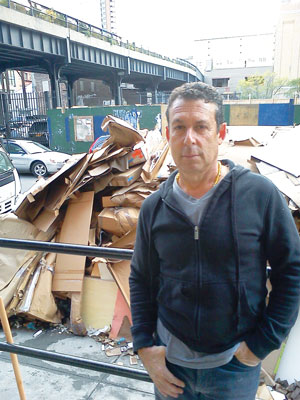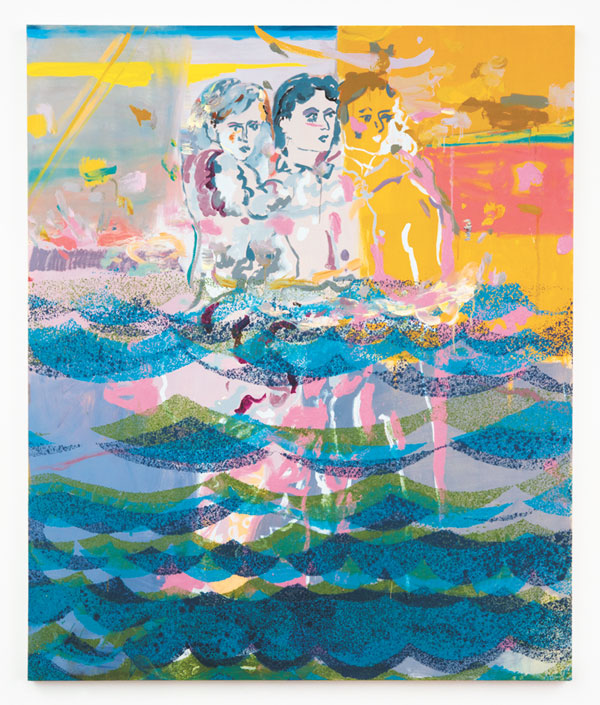
On Nov. 4, gallery owner Jack Shainman takes a break from consigning waterlogged basement items to the trash bin.
BY STEPHANIE BUHMANN | On January 12th, more than ten weeks after the devastating storm surge of Hurricane Sandy hit the Chelsea gallery district with unexpected and unprecedented force, things finally seemed to be getting back to normal. That day, the last group of galleries located on the block of 27th Street, between 11th Avenue and the West Side Highway, officially re-opened after months of arduous and costly repairs.
Jeff Bailey Gallery, Derek Eller Gallery, Wallspace, Winkleman Gallery, and Foxy Production, all of whom experienced major damage due to flooding — inaugurated their 2013 season with newly finished floors and freshly painted walls. Installed on these are now a selection of strong and versatile solo shows, some of which (one consciously, the other coincidentally) make faint references to the storm.
At first glimpse, visitors to the area might feel that not much has changed since Sandy. Galleries are open, the streets abuzz. However, in conversation with local gallerists and artists who show or have their studios in West Chelsea, one finds that this “return to normal” took an incredible effort.
Many of the exhibitions that were scheduled for the fall are currently up on the walls. At David Zwirner, which in late October was just about to mount exhibitions of Luc Tuymans and Francis Alÿs, these installations were postponed, then recently displayed through February 9 (at 519 and 525 West 19th Street). Meanwhile, at Jeff Bailey (625 West 27th Street), where the basement was flooded all the way to the ceiling, Jackie Gendel’s exhibition had only been up for two weeks before the hurricane. Momentum was lost — and while the gallery was renovating, Gendel embarked on a new group of paintings. Some of these, depicting dramatic waterlines, were installed under the title “Revenge of the Same” (which ran through February 9).
“A lot of attention was paid in the press and blogs to the galleries and dealers who lost their inventory or whose businesses sustained damage, but the majority of artists, whose entire livelihood, healthcare and studio practice for one or two years at a time can rest on the sale of just a few crucial pieces (not to mention the feeling of personal loss), weren’t really the subject of that reporting,” states Gendel. She explains that she and other fellow artists, helped their gallerists during the early days of recovery.

Water, water, everywhere: Jackie Gendel’s “Carried Woman II” (2013, oil on canvas, 72 x 60 inches) was part of “Revenge of the Same,” which closed Feb. 9.
“Christian Maychack, Fabienne Lasserre, Louise Belcourt, Chris Gentile, Josh Marsh and others dawned waders or rubber boots, head lamps and gas masks and headed down into the basement where they pulled out work after work. There must have been hundreds. An assembly line was formed from the basement up the stairs to the outside of the gallery, where it was chilly. Work was photographed, taken out of bubble wrap and frames and wiped clean. Later, the assembly line carried work three or four floors upstairs through the darkness to storage rooms to air out.”
Artist Nick Lamia, whose studio is located in the well-known 526 West 26th building that also houses various galleries, Galerie Lelong and Mitchell-Innes & Nash, reflects: “My studio, being on the eighth floor, came through the storm unscathed, but the building itself, and other artists who had things stored in the basement, were not so fortunate. A friend who lives in a loft across the street described that she was able to literally watch the water rising, coming up the street from the river to the west. When it got to the middle of the block, it’s steady progress mysteriously stopped. When she looked more carefully, she realized the water had stopped moving from west to east because it was flooding down into the basement of my studio building, damaging the boilers. We were without heat for two or three weeks.” In fact, 524 West 26th Street still does not have a working passenger elevator, making it hard for some of the businesses in the building to welcome their clients.
Lamia reflects further that for days after the storm, “the sidewalk in front of the building looked like a shanty-town built from the soggy remains of artworks, rolls of drawing paper and canvas, filing cabinets, old desk chairs and other office materials being dredged up from the flooded basement. You don’t see any visible evidence of the storm outside the building now, but the damage remains. There are a significant number of artists who lost much, if not all, of the physical history of their careers.”
‘You don’t see any visible evidence of the storm outside the building now, but the damage remains. There are a significant number of artists who lost much, if not all, of the physical history of their careers.’
—Nick Lamia
Though by now the dumpsters filled with massive piles of ruined office supplies, artwork and other gallery paraphernalia have long been picked up and most water pumps and portable generators have vanished, it is clear that the storm has left behind a major imprint on all individuals involved. However, not everyone is eager to discuss the extent of their losses. Some galleries have to face millions of dollars worth of damages — and worse, some artists have lost most of their life’s work. One art dealer who wished to remain anonymous explained his polite decline to participate in this article by stating that, “In the art world, showing weakness will not get you sympathy…but it might be your downfall.”
Edward Winkleman, who shared reflections and photographs during the past weeks on his blog (edwardwinkleman.com), does feel comfortable discussing his experience. While looking at a stunning large triptych by Michael Waugh featuring a ship battling a massive tidal wave, he explains that he and partner Murat Orozobekov talked about the pros and cons of being open about the challenges they faced. Deciding that they could not hide anyway what was going on (“everybody who was walking by could see themselves how we were doing”), they were surprised to find far-reaching support. During the first most upsetting days, when art works piled up outside on the cold street, the only place to assess the damage in the light due to the lack of electricity, “we asked our artists to stay away until we could review the situation with each one individually.” However, they were surprised to find colleagues, neighbors and also collectors willing to help.
Bailey shares the sentiment: “the outpouring of support has been fantastic, from artists to clients and friends of the gallery. Many people leant a helping hand during those first few weeks, and it made a big difference in getting things done: Moving artwork to storage, cataloguing, photographing, cleaning up. The landlord brought in a disaster recovery team to clean and renovate the spaces.”
Both Bailey and Winkleman note that it was the disaster relief fund, put in place by the Art Dealers Association of America, that helped in their recovery. Founded in 1962, the ADAA is a non-profit membership organization of the nation’s leading galleries in the fine arts, counting about 175 members. Remarkably, their member-funded relief effort was made available to affected members and non–members alike. “The ADAA reached out and provided grants to galleries to help with hurricane related expenses, which was very generous,” says Bailey. “We are almost back to normal, and that will be a welcome change.”
“The relief fund was available quickly,” Winkleman explains, adding that, “It was crucial in a time when we were facing a lot of unexpected bills, like ordering dumpsters.” In the issue of this month’s Artforum, the ADAA took out a whole page ad, listing Acquavella Galleries, Mitchell Innes & Nash, and David Zwirner Gallery, among others, as major donors.
While larger galleries might be able to keep their efforts more private, Gendel points out that “emerging artists and smaller galleries don’t have the luxury of secrecy, the resources to hide the mess, the clout with insurers who wouldn’t pay small timers without the entire public knowing the extent of it.”
The question arises, what kind of long-term decisions have been made. Before Sandy, most ground floor galleries used their basements for inventory storage. Today, nobody will leave anything of great value on a subterranean level.
Though large galleries often have off-site storage in specialized and costly facilities in New Jersey or Long Island City, smaller galleries are now facing the need for renting new additional space above ground. However, rent is of course determined by square footage, no matter if basements are used or not. Only a few Chelsea galleries own the property they occupy. Most are renters, and those who have experienced major damages will certainly re-consider their location as soon as their lease is up for renewal. Nobody I talked to rules out that a similar situation might occur in the near future.
Ultimately, it might be high rents and the shifting demographic of the neighborhood however that will have more impact on the art district than Sandy. With the opening of the Highline, major tourism has swamped the area. On 10th Avenue, between 17th and 20th Street, stores and restaurants rather than galleries have begun to open their doors. In addition, new rental and condo constructions increasingly dominate. Some high-profile galleries have recently looked at Midtown and Uptown as a possible base. Peter Blum Gallery (formerly located on 526 West 29th) recently moved to 20 West 57th Street — New York’s original art district, before Soho and then, Chelsea, became fashionable. Other possible destinations might be Long Island City or Brooklyn — where last year, Chelsea staple Luhring Augustine opened another venue at 25 Knickerbocker Avenue in Bushwick. On the other hand, Hauser & Wirth (which is based in Zurich, London and the Upper East Side) recently opened its massive Chelsea branch in the former Roxy (511 West 18th Street, between Tenth Avenue and the West Side Highway).
Only time will tell if Chelsea will remain the city’s foremost art district or if the scene will become more scattered. In the meantime, galleries have resumed their exhibition programs.
This month, it might be in Gendel’s work that we find one of the most poignant traces of the faceted experience. In her new paintings, the waterline runs through the middle of the canvas — where the gallery would center its plumb line. Though at Bailey, where the water flowed into the basement, Gendel’s line begins to read as high water mark (and for many galleries whose ground floors were flooded, that would indeed have been the case).
Looking at this abstracted memory of a disaster past, one wonders how and when another storm might challenge what we usually deem safe and until then, take for granted.

















